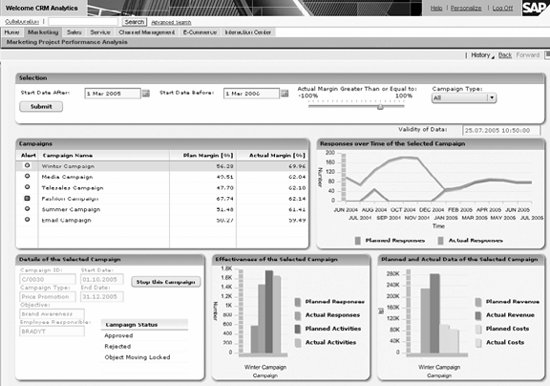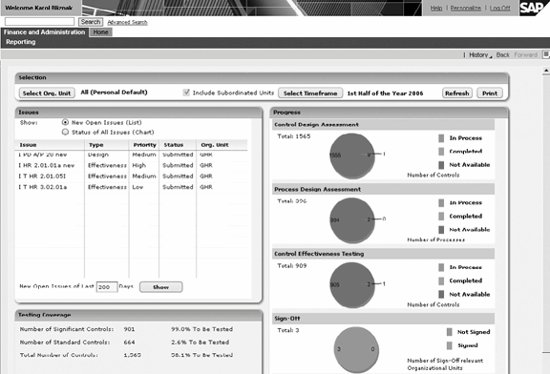Section 11.1. How do SAP xApp Analytics help business users?
|
|
11.1. How do SAP xApp Analytics help business users?Getting the right information from enterprise applicationsEnterprise Resources Planning (ERP), Customer Relationship Management (CRM), and Supply Chain Management (SCM), among othersand into the hands of the people who need it, has sometimes proven costly and difficult. One result is that organizations have had to invest in special environments such as data warehouses, ETL processes, and specialized OLAP tools to satisfy analytic needs. These past approaches, while excellent in their own right, required a different user type and created a new cottage industry of business analysts whose mission was to interpret business data for business users. This slowed the organization's ability to respond, because the business intelligence tools that reported on historical data were disconnected from the business applications and frontline information workers who apply it on a daily basis. Perhaps the biggest drawback was that the information being delivered was arriving too late to be of real value. An enterprise would be in the middle of a sale to a key customer and would have no idea whether the customer was actually profitable or what kind of product they should sell. Like driving a car while looking in the rearview mirror, these opportunities appeared only after the fact and did not help enterprises to anticipate opportunities or swerve away from hazards. The ability to understand processes and receive timely, actionable information in context, with the ability to perform deeper analysis, has long been a desire of every enterprise. For example, knowledge workers responsible for sales do not need generic reports, but rather, information on whom their best customers are and what products they most want to buy. Today's enterprise needs the ability to gather the complete process information in the relevant context, and give users the ability to take appropriate actions: complete, relevant, appropriate, timely, and actionablekey requirements for any solution! SAP xApp Analytics not only help you find your best customer, but also bring you information about his current and past behavior. Then they let you take action on the information: do you want to sell him product A, B, or C, with what discount, and with what payment terms? On top of that, SAP xApp Analytics show you the probability of success in selling one or the other of those three products, or they recommend potential cross-selling options. The following examples of SAP xApp Analytics illustrate how the ideas behind these solutions work in practice. These represent just a small sample of more than 100 different analytic composites delivered to the market. 11.1.1. SAP xApp Analytics for credit managementOne of the clearest examples of the value of analytic composite applications is the application of xApps to the credit management challenge. In the normal course of business, credit managers within a company monitor accounts receivable to determine how much their customers owe. If a customer's balance due rises higher than the customer's credit limit, the order may be blocked and put on a blocked order list. SAP xApp Analytics for credit management improves the process of evaluating a customer's credit, getting a sense of whether the customer might pay the outstanding bills in the future, and communicating how to resolve orders put on the blocked order list. In the past, credit management was frequently a role of the accounts receivable department. Today it is generally an independent role located between the accounting and sales departments. The credit check is executed in credit management, but the required information for credit decisions is spread out all over the company. The process of monitoring all of these receivables and business activities with the customer is very complex. First there are the incoming orders for a given customer. Then there are the outgoing materials, goods, or shipments to the customer in the logistics system. Open invoices from the business accounting system have to be monitored as well. The set of required data includes incoming orders, shipments, open invoices, and credit management, all generally provided from a set of heterogeneous systems, and all with their own data formats. So, the credit manager's goals are to:
The tasks involved in credit management, shown in Figure 11-1, include:
To do this, a manager needs to know:
Figure 11-1. Credit management process Credit management is an important risk control process because a company might have to wait 30 or 60 days after delivering goods to receive payment from a customer. During that time, that customer may be placing more orders. The risk is that if the customer goes insolvent or bankrupt, the payment will never be made. This risk has to be managed carefully to balance the exposure to a customer versus the potential insult of refusing to accept more orders from that customer. The Analytic xApp for credit management brings all the information from all relevant systems into one composite application so that credit decisions can be managed quickly and effectively. Figure 11-2 shows the way the information from a variety of locations is gathered in one place to serve the needs of one role. Figure 11-2. SAP credit management One of the key parts of the Analytic xApp for credit management is the way it helps credit managers work with others in the company to properly resolve orders that end up on the blocked order list. Blocked order list functionality supports the credit manager in deciding whether sales orders that are blocked due to a failed credit limit check should be released or canceled. To come to such a decision, the credit manager needs to have an overview of the most important customer master data and KPIs. Without the Analytic xApp for credit management, the credit manager may have to log in to several different systems to determine how many open invoices the customer has, whether the total dollar amount on the open invoices exceeds the customer's credit limit, which blocked orders should be released, whether the customer owes too much, and whether the customer is having trouble paying invoices. Communication between the sales, credit, and finance departments is very time consuming. The result can be ineffective or slow credit management, which could result in allowing too much or too little exposure to customers. The blocked order list functionality draws data directly from the ERP system and puts it into a table showing the orders that are blocked due to credit limit reasons (see Figure 11-3). Clicking on a customer's name reveals that customer's payment history. This may show that the customer has had a payment problem for many months. Alternatively, it could show that the customer has a seasonal business and has problems every April but that his business always picks up in June, so he starts paying bills in July once cash starts flowing in. The credit manager now has more information regarding whether to release the order, cancel the order, or recheck the credit limit. Figure 11-3. Blocked order listscreen view Only after bringing all of this data together into one view can the correct decision be made in a timely fashion. If a manager decides to release the orderhe overrules the system and says, "OK, I'm taking the risk to deliver the goods to the customer because he promised that he would pay us in seven days"one of the key advantages of the Analytic xApp for credit management is that it allows credit managers to interact with the backend system. It provides the possibility to override the system. The Analytic xApp for credit management also provides an enterprise service to search the blocked order list that can be used to enhance and enrich other applications. For example, the blocked order list enterprise service allows a sales representative's work center to show an alert if any of his assigned customers show up on the blocked order list. The sales representative can then participate in the process of resolving the blocked orders. 11.1.2. SAP xApp Analytics composite application for campaign managementSAP xApp Analytics composite application for campaign management provides an analysis of marketing projects. It is used to pull planning data from the backend CRM system and compare that data with the company's actual progress, telling the user whether target margins are being achieved. The Analytic xApp for campaign management lists all campaigns that have commenced within a specified time, presenting the user with an analysis of planned versus actual costs, revenues, margins, responses, activities, and campaign details, as shown in Figure 11-4. Analytics integrate with the backend system at the transactional level and allow marketers to reject campaigns that are not performing well. Campaigns that the marketing planner rejects are also synchronized with the CRM backend system automatically. This allows the marketer to continue his work without logging into another system. The marketer can be sure the decision is reflected in the relevant business processes. Figure 11-4. Market campaign analysisscreen view 11.1.3. SAP xApp Analytics composite application for corporate governanceSAP xApp Analytics composite application for corporate governance enables Sarbanes-Oxley Section 404 (Sarbox 404) compliance. An Overview application supplies all of the most essential Sarbox 404 compliance data at a glance, including internal control issues resulting from assessments, statistical key figures and the progress of control/process design assessments (see Figure 11-5). Further, a separate set of applications delivers detailed displays concerning control design assessment, process design assessment, and control effectiveness. The Issues Analysis application shows internal control issues and associated remediation plans. And the Sign-off application monitors the status of sign-off activities within a selected area of responsibility. These apps visualize Management Internal Controls (MIC) statistical and detailed data in an intuitive, transparent manner using colorful graphics and animations. The end users involved require virtually no training. Figure 11-5. Corporate governancescreen view In a real-world example, this project delivered six business applications for governance, regulatory, and compliance management on top of MIC capability to SAP AGand it took just five weeks from conception to completion. In the process, additional areas for Sarbanes-Oxley reporting were identified, and an additional two custom-based analytic applications were developed and deployed to support SAP's own reporting needs in the area of compliance. |
|
|
EAN: 2147483647
Pages: 265